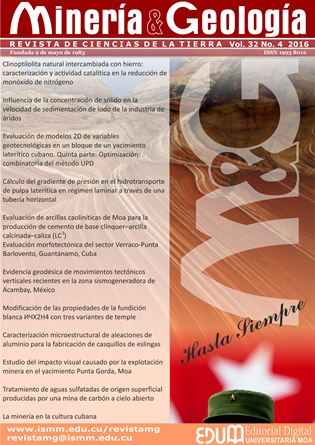Calculation of pressure gradient in laterite slurry hydraulic transport through horizontal pipelines in laminar flow
Keywords:
rheology, Herschel-Bulkley model, laterite slurry, pressure gradient, laminar flow.Abstract
The rheological behavior of laterite slurries with 44% solids and at a temperature of 27 ºC was analyzed to determine the pressure gradients in a horizontal pipeline in laminar flow in order to validate the gradient calculation methodology for this type of fluid based on the rheological behavior. Experiments (particle size, rheological and pressure gradient) were carried out. The resulting gradient values were compared with theoretical values from the methodology used. The results revealed an average particle size of 2,8 μm in the slurry, which explains the plastic behavior of the slurry. In addition the Herschel-Bulkley model describes 87% of the slurry’s rheological behavior. The methodology applied is considered to be effective for the specific conditions established for this investigation with a maximum absolute error of 8,8 %.Downloads
References
BIRD, R; STEWART, W. & LIDTFOOT, E. 1992: Fenómenos de transporte. 2 ed. Editorial reverté S. A., Barcelona, 300 p.
CABRAL, R. A.; GUT, J. A. W.; TELIS, V. R. N.; TELIS, J. 2010: Non-Newtonian flow and pressure drop of pineapple juice in a plate heat exchanger. Brazilian Journal of Chemical Engineering 27(04): 563-571.
GARCELL, L.; DÍAZ, A. & SURÍS, G. 2011: Transferencia de cantidad de movimiento, color y masa. 2 ed. Félix Varela, La Habana, 345 p.
GARDEA, H. 2008a: Bombeo de Fluidos no newtonianos. Caso de los lodos residuales. Rafael Bernardo Carmona Paredes (Tutor). Tesis doctoral. Universidad Nacional Autónoma de México. 171 p.
GARDEA, H. 2008b: Dos propuestas para el proyecto del bombeo de fluidos no newtoninos. Caso de los lodos residuales de plantas de tratamiento de aguas negras. Ingeniería, Investigación y Tecnología IX(2): 87-97.
HERNÁNDEZ, G.; MARTÍNEZ, R.; DURÁN, C. & PÉREZ, O. 2015: Eficiencia energética en sistemas de bombeo de hidromezclas. Minería y Geología 31(3): 109-127.
IZQUIERDO, R.; TURRO, A. & NIKOLAEV, A. 2001: Hidrotransporte del mineral laterítico en régimen estructural. Minería y Geología 18(2): 53-59.
LAURENCIO, H. L.; FALCÓN, J.; RETIRADO, Y. & PÉREZ, O. 2012: Modelo para cálculo de pérdida de presión en tuberías conductoras de petróleo pesado (110 API). Minería y Geología 28(3): 70-86.
MARTÍNEZ, R.; IZQUIERDO, R. & POMPA, M. 2014: Pérdida de carga durante el transporte en régimen laminar de pulpas de cieno carbonatado. Minería y Geología 30(1): 80-94.
MILLER, J. & FREUN, J. 2005: Probabilidad y Estadística para Ingenieros. Felix Varela, La Habana, 737 p.
PÉREZ, L. & GARCELL, L. 2011: Análisis del efecto de las principales variables que determinan el comportamiento reológico de suspensiones limoníticas. Tecnología Química XXXI(3): 106-118.
PÉREZ, L. & GARCELL, L. 2006: Efecto de la granulometría y de las propiedades superficiales sobre la reología de las suspensiones concentradas de laterita. Tecnología Química XXVI(1): 40-47.
PÉREZ, L.; CARDERO, Y.; LAMOTH, Y. & GARCELL, L. 2008: Estudio del comportamiento reológico de una suspensión industrial de laterita. Tecnología Química XXVIII(1): 22-33.
PÉREZ, L.; GARCELL, L.; ROJAS-PURÓN, A. R. & SIMONES, R. 2010: Mineralogía y reología de suspensiónes minerales del proceso de lixiviación ácida a presión en Moa, Cuba. Minería y Geología 26(4): 16-35.
SHANSHI, M. 2004: Piping calculation manual. Mc Graw-Hill, New York, 659 p.
SKELLAND, A. 1970: Now Newtonian flow and head transfer. Ediciones Revolucionarias, La Habana, 400 p.
STEFFE, J. 1996: Rheological methods in food process engineering. 2ed. Freeman Press, 428 p.
Published
How to Cite
Issue
Section
Copyright (c) 2016 Michel Rodríguez-Ismar, Raúl Izquierdo-Pupo, Reineris Montero-Laurencio, Mario Daniel Williams-Rey

This work is licensed under a Creative Commons Attribution-NonCommercial 4.0 International License.
- Authors retain copyright and guaranteeing the right magazine to be the first publication of the work as licensed under a Creative Commons Attribution-NonCommercial that allows others to share the work with an acknowledgment of the work's authorship and initial publication in this journal.
- Authors may establish separate supplemental agreements for the exclusive distribution version of the work published in the journal (eg, place it in an institutional repository or publish it in a book), with an acknowledgment of its initial publication in this journal.
- Authors are allowed and recommended to disseminate their work through the Internet (e.g., in institutional telematic archives or on their websites) before and during the submission process, which can produce interesting exchanges and increase citations of the published work. (See The effect of open access)










